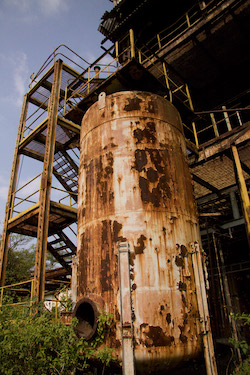SEJournal Online is the digital news magazine of the Society of Environmental Journalists. Learn more about SEJournal Online, including submission, subscription and advertising information.
TipSheet: Hazardous Sites Near You? There’s a Database for That!
The government tracks hazardous chemical facilities because they’re dangerous to local communities. But you would scarcely know it without data-savvy journalists. There may well be a scary story near you and your audience.
The U.S. Environmental Protection Agency keeps data on the “Risk Management Plans” that detail many major hazardous sites — but Congress keeps them from disclosing it too widely. Now the Houston Chronicle has revived the best public database tool on RMPs for environmental reporters. You can find it on RTK Net here.
You may have heard of the Bhopal disaster in India in 1984, which killed thousands and injured many more. That was one of the inspirations for the federal law requiring RMPs. To avert actual federal regulation of chemical safety, the industry allowed disclosure instead. Congress passed the main chemical hazard laws in 1986 and 1990.
But industry soon enough went back on the disclosure deal. In 1999 it got Congress to restrict access to information about facilities that are hazardous because of toxic, flammable or explosive substances they handle. The ostensible reason for restricted disclosure is terrorism.
 |
| A scene from the now-abandoned Union Carbide pesticide plant in Bhopal, India, where a leak in December 1984 exposed more than a half-million people to toxic gas, inspiring federal law in the United States requiring risk management plans. Photo: Bhopal Medical Appeal, Flickr Creative Commons |
It was poor engineering and chemical company neglect that caused Bhopal, not terrorism. And it was not terrorists who caused the disaster when the ammonium nitrate fertilizer depot blew up at West, Texas, in April 2013. It was merely a fire, sloppy handling and bad siting. Among the dead were 10 first responders, arguably killed by lack of information as they rushed toward the fire.
The Obama administration ordered a tightening of chemical hazard rules at all agencies in August 2013. But EPA did not finish its rule until the last days of Obama’s tenure, making it vulnerable.
At industry’s urging, the Trump EPA has put the rule on hold, as part of its regulatory freeze. The tightened rule’s prospects are not good. The Trump administration has signalled its views on chemical safety by proposing to abolish the non-regulatory Chemical Safety Board.
Houston newspaper preserves database
The good news is that the Houston Chronicle has rescued the RMP database from oblivion and committed to keeping it alive. It is part of Right-to-Know Net (RTK Net), formerly housed at the Center for Effective Government, which disbanded in March 2016.
The database does not contain everything in the RMPs. Missing, because restricted, are the “offsite consequence analyses,” which enumerate how many people would die in the event of a catastrophe at each plant. Reporters: if you are motivated, you can still get this information at a federal reading room.
Of course, the Chronicle is neighbor to one of the largest concentrations of petrochemical plants in the nation. But dangerous chemical facilities are everywhere. Sewage and drinking water plants handle chlorine. Food refrigeration plants handle ammonia. And some facilities, like those handling large amounts of propane (LP gas), are exempt. As was the ammonium nitrate at West, Texas.
If you have any doubt that world-class journalism can be based on the stories you can get out of the RMP database, take the time to read the “Chemical Breakdown” investigative series the Chronicle did in mid-2016. Matt Dempsey, Mark Collette and Susan Carroll, the team who reported it, have already won prizes, and may well win more.
But also look for facilities that are not in the database.
If you are working in an area where petrochemical facilities are concentrated, for instance, you may want to pay attention also to the Occupational Safety and Health Administration’s rule on “Process Safety Management.” It is about as close as the U.S. government comes to regulating chemical safety. OSHA makes available data about violations and enforcement of its rules.
While workers and first responders are often the first victims of chemical leaks and explosions, it is crucially important to think about the people who live, work and go to school near a hazardous facility.
For example, the Center for Effective Government used RMP data to look at the risks to schoolkids in each Congressional district. And do not ignore the environmental justice angle — poor people and minorities often live closest to hazardous facilities. The center did a good report on that also.
* From the weekly news magazine SEJournal Online, Vol. 2, No. 14. Content from each new issue of SEJournal Online is available to the public via the SEJournal Online main page. Subscribe to the e-newsletter here. And see past issues of the SEJournal archived here.













 Advertisement
Advertisement 



